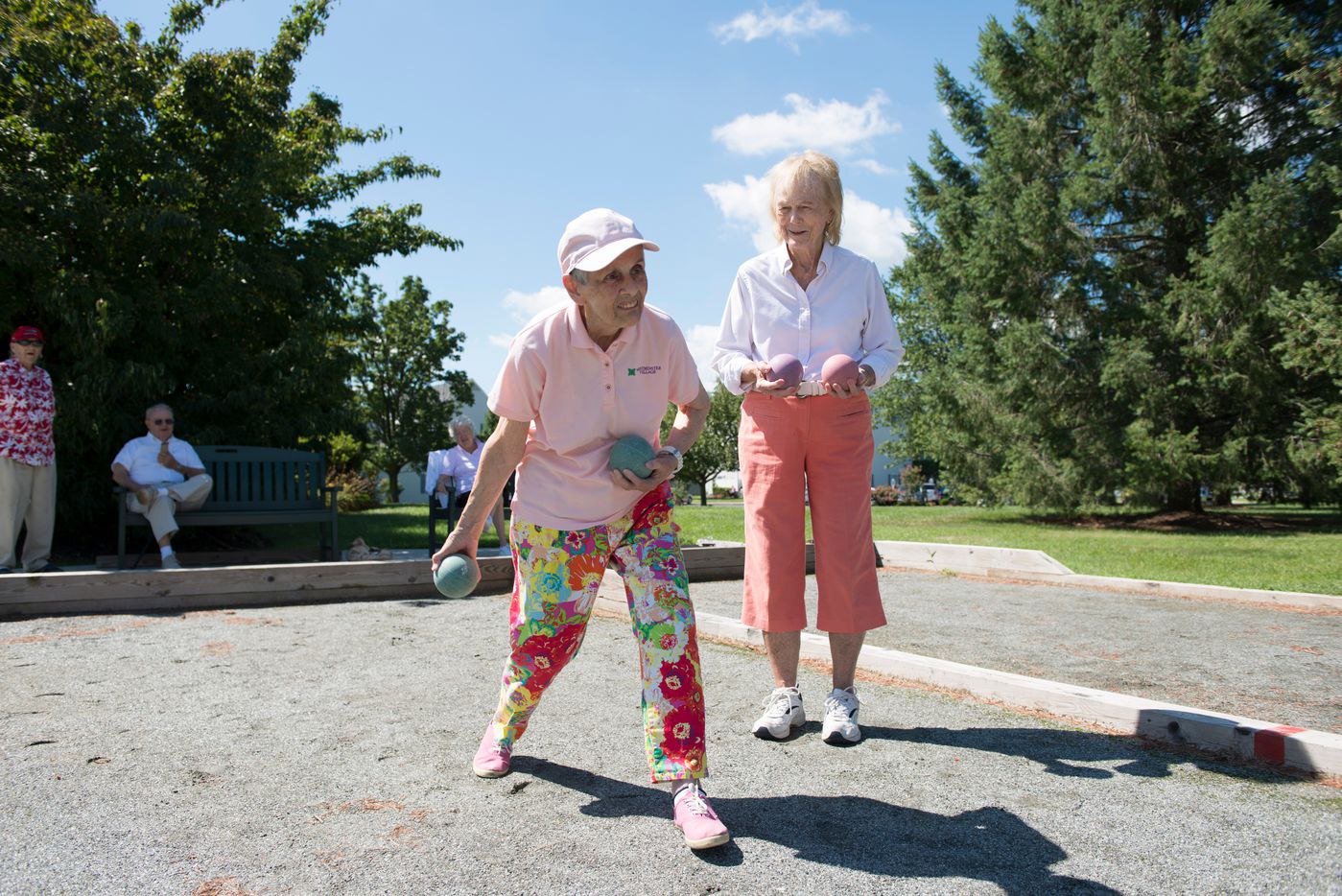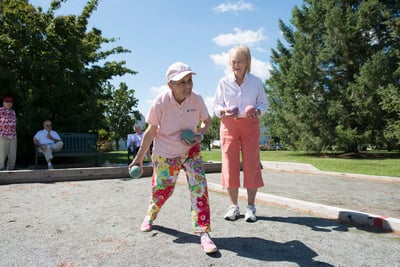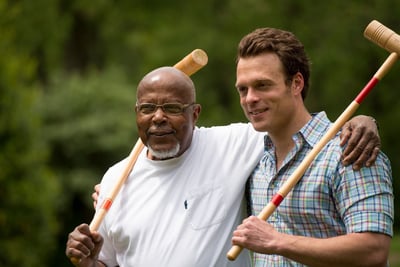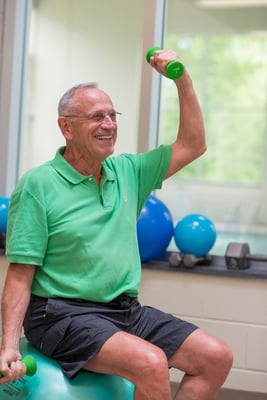
Lifelong Fitness for Wholeness of Body, Mind and Spirit
Updated from the original publication on October 25, 2016.
 Physical fitness is an important component of healthy aging, but it’s not the only kind of fitness that’s important. At Presbyterian Senior Living communities, we offer residents opportunities to participate in activities that improve lifelong fitness, including brain fitness and overall mental and physical fitness. There are a wide variety of activities and habits that help promote overall wellness and health. What you choose to do isn’t as important as choosing to do them consistently!
Physical fitness is an important component of healthy aging, but it’s not the only kind of fitness that’s important. At Presbyterian Senior Living communities, we offer residents opportunities to participate in activities that improve lifelong fitness, including brain fitness and overall mental and physical fitness. There are a wide variety of activities and habits that help promote overall wellness and health. What you choose to do isn’t as important as choosing to do them consistently!

Not looking forward to winter? Download our Winter Survival Guide for Seniors!
Are You Making Smart Fitness Choices?
When it comes to making lifestyle choices regarding staying active and fit, there are a myriad of options that can provide significant health benefits. Whether you are lifting weights or using a treadmill, performing yoga or Tai Chi, participating in a water aerobics class or simply walking with a friend, there are many great senior living lifestyle options for those interested in maintaining or improving their health.
 And there’s certainly not a “one size fits all” exercise program that works for everyone. Especially for people who have physical limitations or a disability. Some types of exercise may simply be unattainable. Always remember to check with your healthcare professional before beginning any exercise regiment.
And there’s certainly not a “one size fits all” exercise program that works for everyone. Especially for people who have physical limitations or a disability. Some types of exercise may simply be unattainable. Always remember to check with your healthcare professional before beginning any exercise regiment.
It's important to keep in mind that exercise or physical activity doesn’t have to be structured or complicated to provide health benefits. Normal everyday tasks like performing light housekeeping or slowly walking can be beneficial when compared with the effects of a sedentary lifestyle on an individual’s health. It is also important to remember that physical activity doesn’t have to consume large blocks of time. Even short bouts of physical activity provide significant health benefits.
Fitness Tip: Every Little Bit of Physical Activity Can Contribute to Better Health
A recent study published in the Journal of the American Heart Association reinforces the idea that no matter your fitness level or ability, every little bit of physical activity can contribute to better health. Researchers at the University of Florida Institute on Aging, in collaboration with several other universities, have developed the Lifestyles Interventions and Independence for Elders Study (LIFE) to explore the lifestyle interventions that may help older adults maintain their independence and promote overall health.
 Using data from the study, researchers concluded that for every 25-30 minutes an individual is sedentary throughout the day, their risk of heart attack or coronary death increased by one percent. They also found that repeated bouts of light activity throughout the day were correlated with elevated levels of HDL “good” cholesterol levels.
Using data from the study, researchers concluded that for every 25-30 minutes an individual is sedentary throughout the day, their risk of heart attack or coronary death increased by one percent. They also found that repeated bouts of light activity throughout the day were correlated with elevated levels of HDL “good” cholesterol levels.
“Reducing time spent being sedentary even by engaging in low-intensity activities could have important cardiovascular benefits for older adults with mobility limitations,” said Thomas W. Buford, PhD, senior author and director of the Health Promotion Center of the University of Florida Institute on Aging. “In the past, much of the emphasis was placed on engaging in structured physical exercise,” Buford said. “It is becoming increasingly evident, however, that encouraging individuals to just reduce the amount of time they spend being sedentary may have important cardiovascular benefits.”
As our society has progressively moved towards a more sedentary lifestyle, the increased prevalence of chronic health conditions has been dramatic. However, reducing your risk for these chronic conditions is as simple as incorporating more physical activity into your day.
How Often Should I Exercise?
Frederick Wall, one of our community Fitness Directors, says this:
“As a fitness professional one of the questions I am frequently asked is “how often should I exercise?” While the answer may differ from person to person based on individual needs and goals, organizations such as the Centers for Disease Control and Prevention (CDC) and the American College of Sports Medicine (ACSM) publish general guidelines for people to follow in order to promote overall health and well being.
Both the CDC and ACSM recommend that individuals engage in at least 150 minutes (2 ½ hours) of moderate intensity aerobic activity per week AND muscle strengthening activities that target all major muscle groups on at least 2 days per week. It is also important to engage in activities you enjoy; whether it is a walk through the woods, taking a water aerobics or yoga class, or going for a bike ride around town. Enjoying the time you spend being active ensures that you will continue to make physical activity part of your daily life!
Exercise to Keep Your Body and Your Mind in Top Shape
For many people, the goal of exercising is often related to changing our physical appearance or improving our physical health. I can’t count how many times I’ve heard from people that they are trying to “tone up” or shave a few inches from their midsection, lower their blood pressure, or reduce medication. While these goals are all motivational and great reasons to start exercising, rarely do I hear people saying they are exercising to improve their brain health.
There are many “brain games” that promote increased cognitive function and mental acuity. However, the best way to sharpen your mental skills is to engage in aerobic activity. “Exercise is the single best thing you can do for your brain in terms of mood, memory, and learning,” says Harvard Medical School psychiatrist John Ratey, author of the book, Spark: The Revolutionary New Science of Exercise and the Brain. “Even 10 minutes of activity changes your brain.”
Here are a few examples of how exercise can have a positive effect on cognitive function:
Improves Learning
Exercise increases the level of brain chemicals called growth factors, which help generate new brain cells and establish new connections between brain cells—aiding in the learning process. For those looking for an even bigger brain boost, complicated activities like playing tennis or taking a dance class provide even more mental stimulation. “You're challenging your brain even more when you have to think about coordination,” explains Ratey. “Like muscles, you have to stress your brain cells to get them to grow.”
Improves Mood
“Runner’s High” really does exist, especially if you're willing to shift into high-intensity mode. Jumping on the treadmill or cross trainer for 30 minutes can reduce tension and stress by increasing levels of soothing brain chemicals like serotonin, dopamine, and norepinephrine. Ratey recommends sprint bursts through interval training. Run, bike, or swim as fast as you can for 30 to 40 seconds and then reduce your speed to a gentle pace for five minutes before sprinting again. Repeat four times for a total of five sprints. “You'll feel really sparkly for the rest of the day,” he says.
Decreases Risk of Cognitive Decline and Disease
The Alzheimer's Research Center touts exercise as one of the best weapons against the disease. Exercise appears to protect the hippocampus, which governs memory and spatial navigation, and is one of the first brain regions to succumb to Alzheimer's-related damage. Even mild activity like a leisurely walk can help keep your brain fit and active—fending off memory loss and keeping skills like vocabulary retrieval strong.
What about Brain Exercise?
Ponder the phrase "use it or lose it" the next time you spend hours in front of the television set or ask someone else to "think" for you. Then consider that two-pound enigma nestled safely within the confines of your skull. Right now, billions of neurons are behaving like hyperactive toddlers in your brain, constantly communicating and making new connections with other neurons via electrochemical signals.
 You're probably wondering what these restless brain cells are saying to each other. Well, neuroscientists know exactly what they are saying--
You're probably wondering what these restless brain cells are saying to each other. Well, neuroscientists know exactly what they are saying--
We want something to do!
Although a bored toddler may channel their frustration into doing things they shouldn't, neglected brain cells tend to stop talking to each other. Without external stimulation keeping them healthy and active, neurons will just sit there and do nothing. No more new connections with other neurons, no growth, no nothing. Just like muscles that aren't moved or exercised for lengthy periods will atrophy and become useless, so will your brain.
Why Brain Fitness is so Important for Seniors?
Seniors especially need to engage in brain fitness exercises to stimulate the "thinking" part of their brain--the frontal lobe. Necessary for maintaining cognitive skills, memory, judgment, problem solving and motor functioning, your frontal lobe could be considered the "cockpit" of your brain. Imagine an airplane without a cockpit--it couldn't fly or taxi down the runway. In fact, it couldn't do anything except take up space!
So let's get started pumping up that muscle in your head with these brain fitness programs designed especially for seniors:
1. Physical Activity
As discussed previously, exercise improves functioning of the hippocampus (working memory and long-term memory). Research indicates that exercising regularly may help prevent or delay Alzheimer's disease. Exercise also promotes positive feelings by stimulating the release of endorphins, or special chemicals containing analgesic/mood enhancing properties. A happy brain is a healthy brain!
2. Artistic Endeavors
Join an oil painting, sculpturing or sketching class at your local arts center. Or just channel your inner muse at home. Either way, drawing or painting stimulates both brain hemispheres--the logical and the creative parts of your brain. Holding a pencil or brush in your hand is also a good way to strengthen your fine motor skills and regulate hand and finger movements.
3. Learn a Second Language
One of the best ways to exercise your brain is by learning another language. Just learning commonly used phrases in a second language utilizes neurons vital for relaying messages throughout the brain. Learning another language also promotes higher-order operations, such as organizing, memorizing and expressing ideas.
4. Puzzles, Puzzles, Puzzles
Jigsaw puzzles (at least 500 pieces), crossword puzzles and word search puzzles provides the kind of "brain food" neurons love to feast on. Doing puzzles also improves focus, concentration and memory skills in seniors.
5. Readin', Writin' and 'Rithmetic
Reading, writing in a journal and doing math problems are great ways to build your brain muscle. You can find free books to read online here or brush up on your math skills here.
6. Online Brain Fitness Games for Seniors
These online games are designed to help stimulate the frontal lobe, and will challenge you while working out your brain:
7. Masterpiece Living
Masterpiece Living is a direct descendant of the landmark MacArthur Foundation Study on Aging. The customized process that is based on data and thoroughly tested, assists senior living organizations in creating supportive environments to help aging individuals thrive. Masterpiece Living creates benchmarks that measure individuals and their successful aging requiring several vital components:
- Engaging socially with others.
- Developing a sense of purpose and meaning in life.
- Maintaining a lifestyle that is physically active and mentally challenging.
- Being in a supportive atmosphere.
At Presbyterian Senior Living, Masterpiece Living is changing the experience and perception of aging on a daily basis. Click on the links above to read four diverse stories demonstrating how Masterpiece Living helps create rewarding, dynamic lifestyles.
About Presbyterian Senior Living
As the trusted leader in aging services, Presbyterian Senior Living combines over 97 years of experience with innovative approaches to senior communities and services. Across our 27 communities in PA, MD, OH, and DE, we serve over 6,000 seniors. We are committed to: FOSTERING teamwork and responsibility. UPHOLDING integrity in every action. EMBRACING innovation to create opportunities for everyone’s success. LEADING with compassion and respect.


